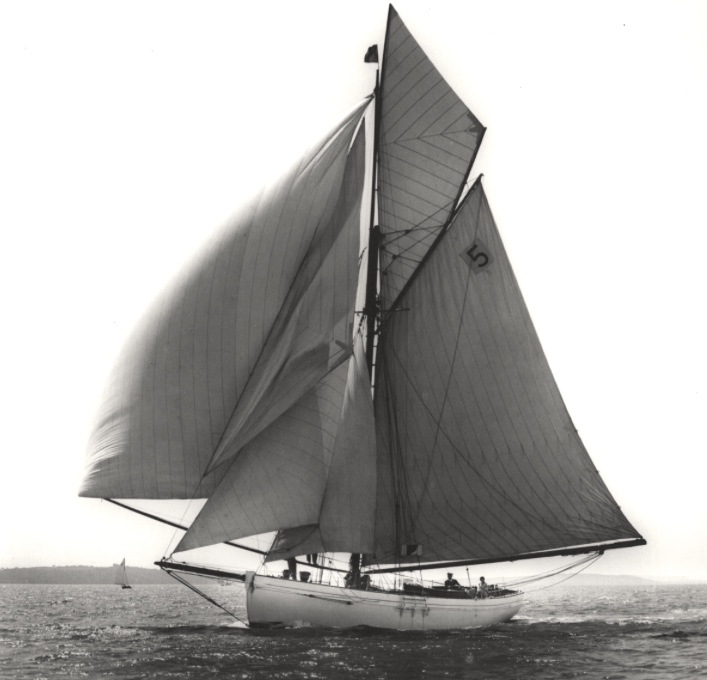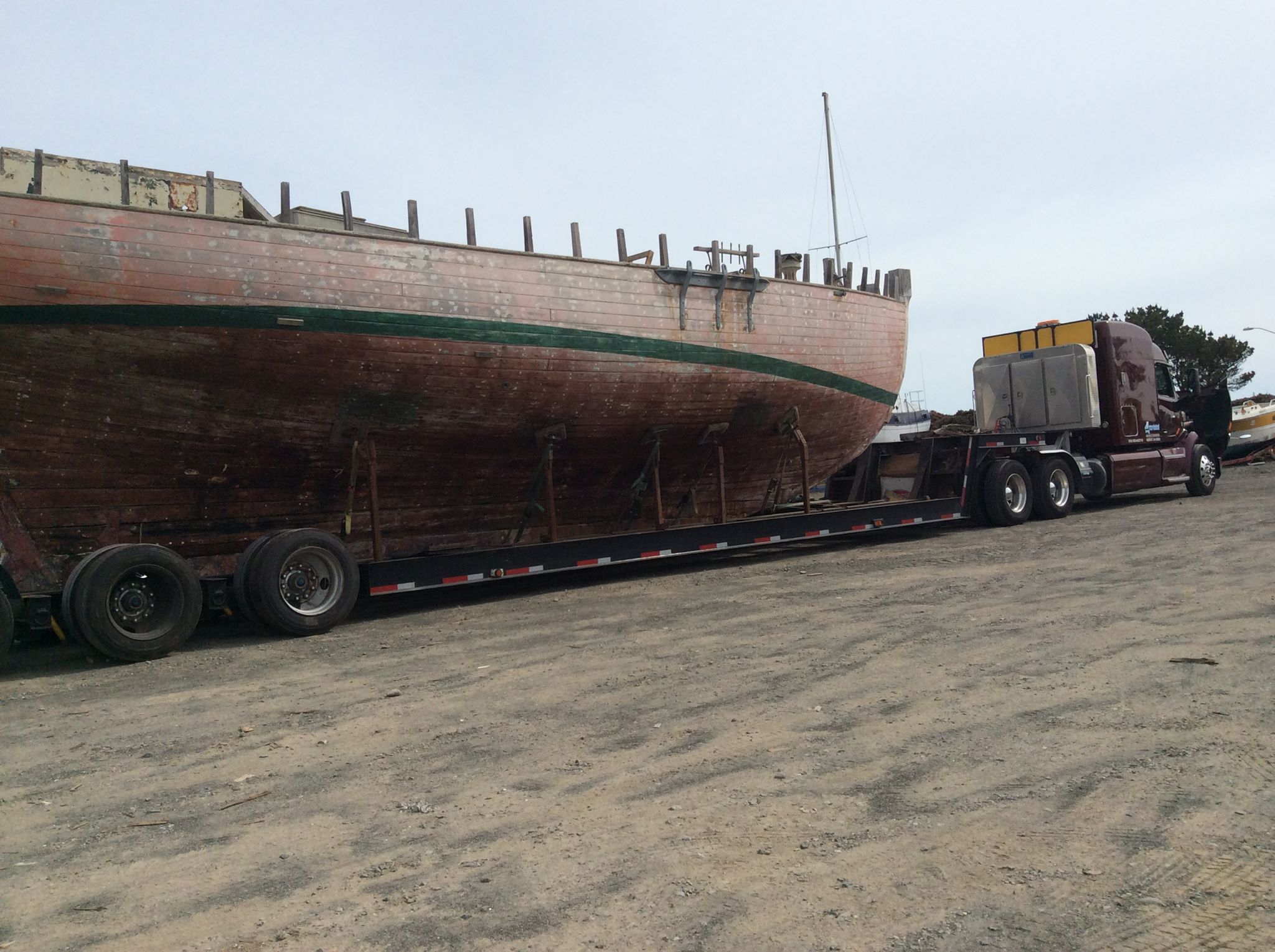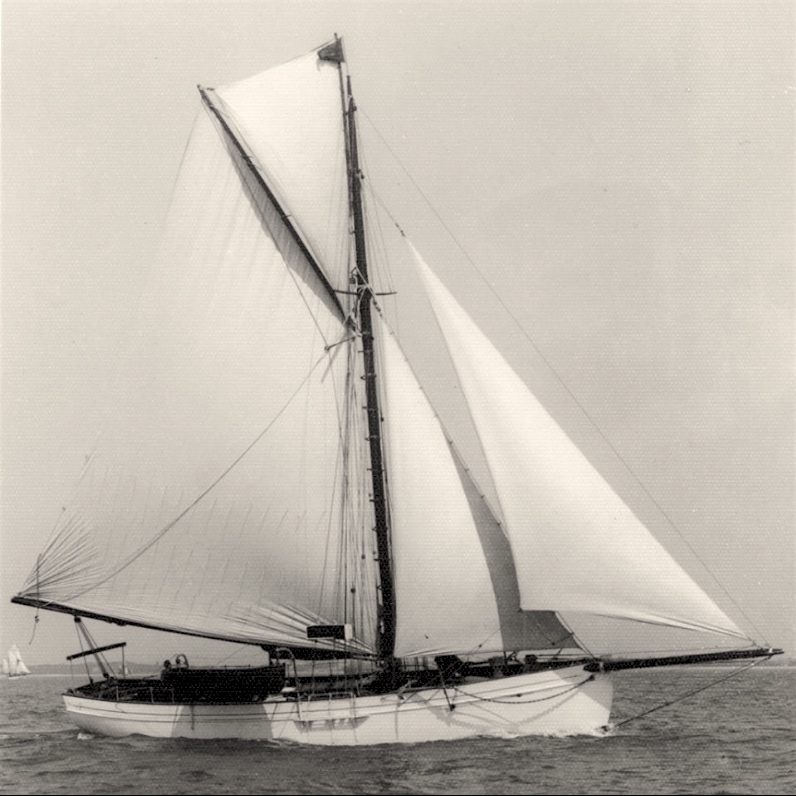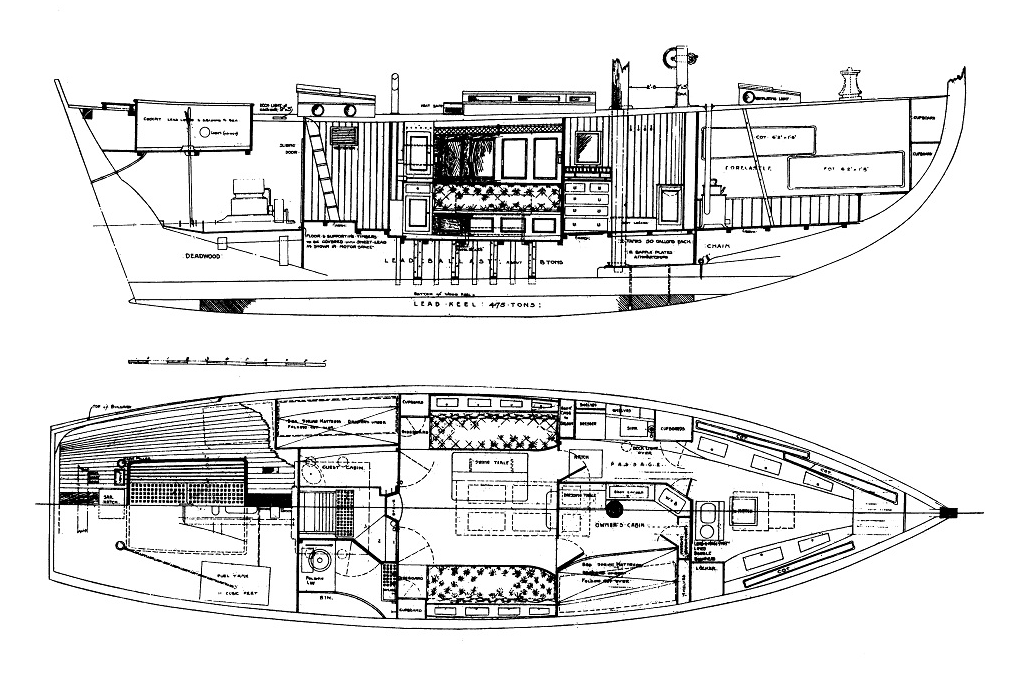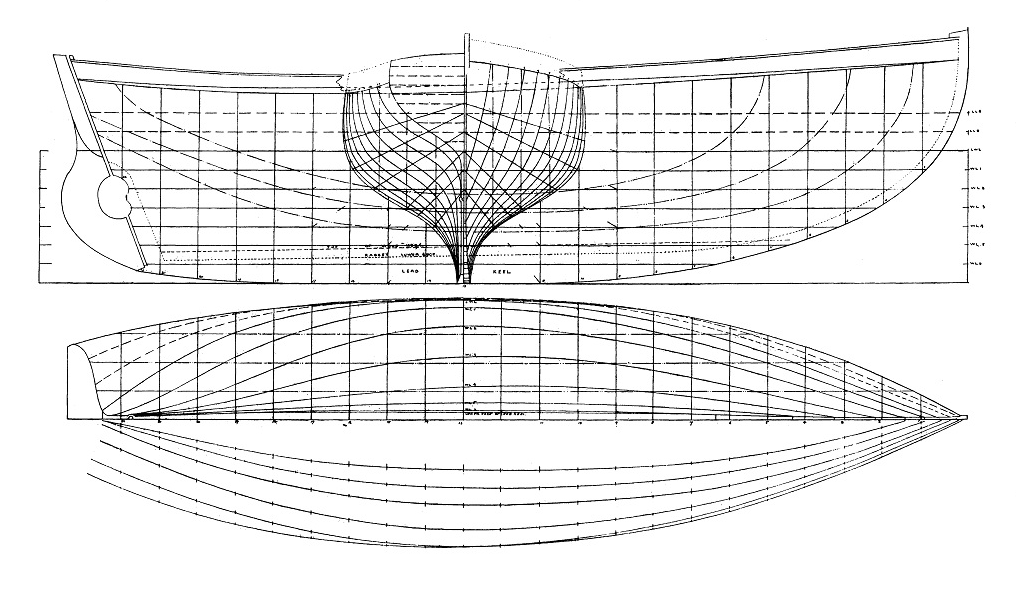From Classic Sailor issue 17, September 2017
We talk to Leo Goolden who has saved the Albert Strange designed 1927 Fastnet winner from the chainsaw – plus a vivid
account of the race itself
by Thad Danielsen
The restoration of Tally Ho has been a long time coming. For three decades the Albert Strange-designed winner of the 1927 Fastnet Race has languished under a tarpaulin in a boatyard in the American port of Brookings, Oregon. In 2008, the port authorities, which had assumed ownership against unpaid storage fees, sold her to boatbuilder Manuel Lopez, who began work on her, but died in 2010. In 2012 the port did a deal with the Albert Strange Association which set up a company to hold title to the boat, paid storage fees, found a member, Pat Kellis, to keep an eye on her and advertised her for sale at £25,000.
But earlier this year the port embarked on a programme of clearing and smartening up it, and gave the ASA a deadline of June to take Tally Ho away or face the prospect of having her broken up.
At this point, enter Leo Goolden, the young British boatbuilder who had already made a name for himself with his restoration of a 1947 Folkboat. He paid the ASA the proverbial £1 for Tally Ho, found some land in Washington State, some 600 miles away, moved Tally Ho there and set to work. Which all sounds very straightforward if you write it quickly like that. For a more realistic picture of the work involved – ground clearance, truck manoeuvring, and a guided tour of Tally Ho herself, see Leo’s video blog at his sampsonboat.co.uk. website. Sampson is his middle name, which bodes well.
We caught up with Leo just before this issue went to press, and pitched a few questions at him, starting with the traditional “How are you feeling?”
“I’m still feeling really excited and happy about the project at the moment. I’ve had to leave the USA for a few weeks, and all I can think about is getting back to Tally Ho to get started. I do sometimes wake up wondering what the hell I have got myself into, though. I usually feel confident about it again after a cup of tea. “I’ve moved her to a site near a town called Sequim, in Washington State on the Olympic peninsula. It’s a remote but very beautiful area, with pleasant (if a little wet) weather, great timber, and access to traditional marine trades in nearby Port Townsend. I have access to a workshop there and have already built a large cover over the boat.”
Do you have a plan of work yet? “I do have a vague plan, but it will obviously evolve as the project gets underway. The first stage is to get the workshop and accommodation sorted. I have some optimistic ideas about the timescale in my head, but I’m trying to avoid talking about it too much, as we all know that these things take longer than expected!”
How much needs doing? “It might be easier to describe what I think could be saved; the ballast keel, the huge (teak!) keel timber, some of the rest of the centreline, half to two-thirds of the planking, transom, maybe a few frames, and the deck hatches.
“I think everything else will have to be replaced; lots of frames, deck beams and deck, stem, and so on and so on, ad infinitum.”
Will you restore her as she was designed? “I hope to do so as far as is practically possible, although I think I will draw the line at a paraffin engine. I haven’t made a final decision about the interior layout yet.”
Can you do this full time? “I have been carefully saving for a couple of years, and so I can start off full-time, but the time will come when I have to go and top up the bank account, unless I come across some funding.”
Why did you buy Tally Ho? “On a personal level, it’s the calling of independence and challenge. It’s about risking everything for something stupid and beautiful. And most of all, it’s about doing something that will make a good story – because for me, that is important in life; to have good stories to tell, and to have good people to tell them to.
“In the bigger picture, it’s about a piece of history that is in danger of being lost forever. Tally Ho is a notable yacht from an esteemed designer. She gained fame for winning the third ever Fastnet race in 1927, beating proven vessels such as Jolie Brise and Ilex. Later in life she proved herself as a sea-kindly world-cruising yacht, although she was eventually nearly lost to a Pacific reef and subsequently disappeared off the radar. She was rediscovered years later in a tiny port in Oregon, where she had been fishing Salmon before being left to rot on the dock. Since then there have been various attempts to save her, but her obscure location and state of disrepair have made it very difficult.”
Can you see yourself sailing her in the Fastnet? “Absolutely.”
How Tally Ho won the 1927 Fastnet race
Thad Danielsen paints a tack-by-tack picture of a particularly gruelling early
edition of the famous race
Tally Ho was built as Betty for Charles Hellyer at Shoreham by Stow and Son in 1910 to an Albert Strange design. Hellyer had fishing interests in Brixham, as well as in Hull, and was a member of Strange’s Humber Yawl Club.
The commentary which accompanied the publication of the design in the Yachting Monthly in 1910 remarks that Hellyer required a yacht in which he could cruise in comfort whilst indulging in deep-sea fishing. This explains the barrel windlass forward of the mast and perhaps the unusually clear flush deck. The article continues: “The transom stern, rather unusual in a yacht of this tonnage, was adopted in deference to the wishes of the owner, in order that she might lie in the crowded harbour of Brixham in the smallest possible space.”

Albert Strange has a society dedicated to his boats and is regarded as one of the best yacht designers of his day
At 47ft 6in and 30 tons TM, she was the largest transom-sterned boat designed by Albert Strange. After a year, though, Hellyer decided to order a larger, counter-sterned design, Betty II, from Strange and put his original Betty up for sale.
After two other owners and one name change (to Alciope) she was purchased by Lord Stalbridge, Hugh Grosvenor, a sportsman who renamed her again, to Tally Ho, and had her rig enlarged with a fidded topmast. The crew divided into two watches, one the owner and Mr Peter Bathurst, the other the owner’s son, another Hugh Grosvenor, and Jim Wills, a paid hand. Of two other paid hands aboard, Mark Spinks was to be available at all times and Lou Springett, cook and steward, was also called when needed.
They had cruised to Spain, twice crossing the stormy Bay of Biscay, and now were entered in the third Fastnet Race. August 12, 1927, Friday, in a summer of storms. A gale whistled around the clubhouse and through the windows of the Royal London Yacht Club after the pre-race dinner as the race committee chairman announced that the ‘S’ postponement flag might be flown if conditions did not improve by next day’s 11:30 start. Rowing with the chop back to Tally Ho, tugging at her anchor in the Medina, none knew what the next days would bring, but they certainly had some idea.
Wet manilla halyards and sheets swell and shorten when wet. Everything on Tally Hoʼs deck was wet after days of rain. The heavy canvas mainsail went up as the windlass cranked the anchor chain aboard. With jib and forestaysail up she fell off, reaching out of the Medina with the tide, ebb in the early morning to flood by race time. As the hour of start approached the gale softened, showers lightened. The Southampton shore was lost to sight in fog and rain.
Tally Ho raised her jib topsail while Jolie Brise and the two Alden schooners spread their balloon spinnakers. Tally Ho hit the line first but was soon overtaken by these longer vessels with their big sails. Broad reach to No Manʼs Land Fort in the lee of the island, sea quiet… but this was soon to change.
Hardening up, close reach to Bembridge Ledge, the spinnakers ahead came in and Tally Hoʼs jib topsail too as they came on the wind, the breeze also hardening up after its lull. From Bembridge Ledge, heading for St Catherineʼs Point, the southern tip of the Wight, tacking dead into the rising wind, tide assisted, soaking spray wet what the rain didnʼt, as sharp waves built against the current. Approaching the St Catherineʼs Tally Ho went ahead of La Goleta, give and take that would go on to the end of the race.
Rounding, the gale returned in force and seas now clear of land swept the boats as they went on port for Christchurch Bay. Jolie Brise and Nicanor led the fleet, ahead of Tally Ho, with the Royal Engineers’ yawl Ilex and the cutter Spica abreast of her and La Goleta just astern. The smaller of the 15 starters were left behind and lost to sight from then on.
Was there still the mile or so visibility theyʼd had at the start… or were they sounding with lead as they approached the entrance to Poole? Tacking to keep in the shelter of land in Studland Bay from 6:30 off Poole until midnight, when she finally rounded St Albans Head. Feeling the wind increase, the crew paused to reef and continue tacking toward Portland Bill under reefed main and topsail. At 4am, they shook out the reef, and crossed West Bay by 8am with enough visibility to see Jolie Brise under the land off Teignmouth, Nicanor to windward, Ilex abeam and La Goleta just astern.
More tacking, to weather Start Point by 6pm, and more of the same against wind and tide to Eddystone lighthouse. Slow going, still 3 miles east of the light at midnight. By 4am the tide had turned and helped sweep them well past Eddystone, making for Dodmanʼs Point. Now the SW gale had veered to north of west, still strong with powerful gusts. Spica and La Goleta had fallen back, Nicanor and Ilex tacked along off Falmouth, Jolie Brise seen ahead near the Manacles. With the new breeze and gusts laying her over Tally Ho made the Manacles by 11am to see Jolie Brise coming back. As they passed, they said it was too rough.
With all hands on deck tying two reefs in the main, Tally Ho’s crew put the canvas covers on the hatches and prepared to round the Lizard. This work in hand, Nicanor came up and, when told what Jolie Brise had said, turned back. Ilex meanwhile was seen headed out all up but then running back jib and jigger. Confident in her rig and her handling of a storm in the Bay of Biscay, this was Tally Hoʼs chance.
Coming free of the land, Lord Stalbridge said the blast of wind and sweep of seas “was enough to make you think”. Still, after a wave hit her throwing spray over the mainsail, she carried on and took her tack easily. Then they were passed by a tanker showing almost half her keel as the seas swept under her. Two more tacks and they cleared the Lizard by 4pm.
Seeing no sign of any other boats rounding the Lizard, Tally Ho anchored off Newlyn well before dark. Here the paid crew was given the night off while the owner and his amateur friends took their watches in the saloon.
Quiet except for the gale still whistling in the rigging overhead, I imagine a hearty breakfast at anchor, and feeling a lightening of force in the wind after sun up. Anchor up and sails set Tally Ho was off by 6:30 on a moderate NW breeze. Reach out past Lands End then long tacks through the fourth day of racing until 10pm past Sevenstones into the Irish Sea. The wind went SW and Tally Ho could head straight for the Rock. It was a beautiful night, sailing free!
Dawn the fifth day they saw a white sail astern that worked its way up through the day, turning out to be a schooner abeam, well off to starboard, by 3pm. Clouds held off for sights until after noon, when the breeze backed to the south, taking Tally Ho away from her pursuer, but the glass fell through the day telling of things to come. Lots of tide sweeps in and out of the Irish Sea, complicating compass navigation. By 6pm Tally Ho was judged 11 miles SW of the Fastnet Rock. The schooner had recently crossed her bow and now both cutter and schooner turned NE in near calm and fog, drifting and catching flukes of breeze toward their imagined goal, which materialized, the light being lit as night came. Coming together, the schooner turned out to be La Goleta.
Catching a puff in her high topsail Tally Ho rounded first, at midnight, the beginning of the sixth day, La Goleta soon following. They had about 250 miles to go, a day and a half with La Goleta giving Tally Ho almost five hours on handicap. When just clear of the Rock the glass’s predicted storm came on from the NE. With the fresh gale raging against the SW swell, Tally Ho charged on, Lord Stalbridge said: “more under water than over I fear”. That from 2 to 4am, then they reefed. La Goleta had taken in all but her foresail and forestaysail, still doing 6 knots but losing more ground to Tally Ho. Tally Ho tucked in a reef at 4am to ease their way, but still made time on their competitor until 10 when the wind moderated and went NW. With the reaching breeze, La Goleta reeled Tally Ho in during the afternoon, but half the way to Plymouth still remained.
The storm eased but the gale continued,. Tally Ho shook out her reef, La Goleta adding main and reacher, the swells rolling under the yachts, alternately surfing and wallowing into the dark of night. La Goleta took in the reacher but drove on, waiting to see what dawn would bring. Still dark when La Goleta made out the Longships light vessel, and began her run to the Runnelstone.
Tally Ho came on Sevenstones in early dawn, 4am, still in view of the leader. That was the race. They ran to the Runnelstone, then the Lizard and reach in to Plymouth, La Goleta was first across the line by 47 minutes but losing on handicap by four hours.
What of the other 13 starters?
Conor OʼBrienʼs Saoirse tacked back and forth in the Channel for three days before retiring to the Solent. Altair and Maitenes split their mainsails. Nelly and Penboch wore out their crews. Morwenna had the dinghy shift on deck, injuring one of the crew. Shira couldnʼt keep up with leakage and Spicaʼs bilge pump failed with the same result. Thalassa blew out her headsails. None of these yachts made it past the Lizard. The Royal Engineers in Ilex, who had won in 1926, got almost to the Longships where they blew out the No 2 jib and found the forepeak leaking badly, so returned to Plymouth. Nicanor, another Alden schooner got half way to the Fastnet Rock before a broken gaff induced them to retire. Content blamed a faulty compass for ending up on the Irish east coast instead of the Rock off the SW.
Tally Ho’s next sixty years
The 1927 Fastnet might have been Tally Hoʼs only race. I know of no other. Lord Stalbridge kept her for another year and sold her to a man named Tuckett who kept her until World War II.
After the war she was owned by Edward C Dix until 1954, when she was taken over by CWS and Mrs. RH Clark (shown that way in Lloyds Register). According to their eldest daughter, Frances Flutter, they bought her as an affordable home. In 1958, with their two girls aged 10 and 5, the Clarks took Tally Ho to the Caribbean and then back to England via Bermuda and the Azores.
In 1967 she was purchased by Jim Louden, a New Zealander, who proceeded to sail her for home. After a spell in the Caribbean, he sailed solo to Polynesia. Offered a job hauling copra, he took a boy as crew and headed for his loading site, and arriving at night he left the boat in the hands of the boy and retired. Both were awoken when Tally Ho came up on the islandʼs reef.
Dragged off the reef much damaged, she was rebuilt under new ownership, taken to Hawaii and sold to Dave Olsen a fisherman from Brookings, Oregon. He renamed her Escape (rather appropriately) and surface longlined for tuna and swordfish out of Brookings for more than 10 years before abandoning her there in 1987.
And there she remained, ashore under various ownerships until 15 June this year (2017) when Leo Goolden loaded her onto a truck and took her off to Washington for her new lease of life.
Leo’s restoration and early voyages on his Folkboat Lorema can be read: HERE
Check out Leo’s videos and the progress of the restoration (currently at 42 episodes) since this article at sampsonboat.co.uk


